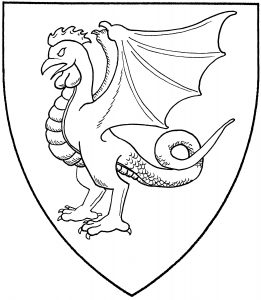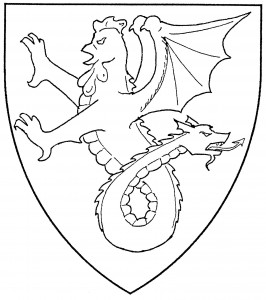The cockatrice is an heraldic monster, generally depicted as a wyvern with the head of a cock. It was reputedly hatched from a cock’s egg, and was able to kill with a glance. It’s a period charge, found in the arms of Baumberg, c.1340 [Zurich 495]. As with the wyvern, early heraldry might depict the cockatrice with feathered wings instead of bat’s wings.
The cockatrice has often been confused in heraldic literature with the “basilisk”; this monster, shown in classical Greek art wearing a crown, differs in heraldic art only by the addition of a dragon’s head on the end of the tail. The basilisk is occasionally blazoned an “amphysian cockatrice” for that reason. (Needless to say, since the crown is a reserved charge in the Society, Society heraldry doesn’t use the Greek definition.) By whatever name, the basilisk was the badge of Cursson, c.1513 [Walden 203].
The default posture for both the cockatrice and the basilisk is statant, with wings addorsed. However, unlike the dragon or the wyvern, the cockatrice was also found displayed in period, as in the arms of Buggin, 1578 [Dennys 186]. The illustrations show a cockatrice statant and a basilisk erect.
Genevieve de Lyonesse bears: Per saltire azure and sable, a cockatrice statant argent.
Cristoff Gockerhan von Loch bears: Gyronny azure and argent, a cockatrice displayed gules.
Theodulf of Borogrove bears: Argent, an amphisian cockatrice gules within a bordure nebuly sable.
Irene of Kensington bears: Vert, a basilisk statant, wings addorsed argent.

